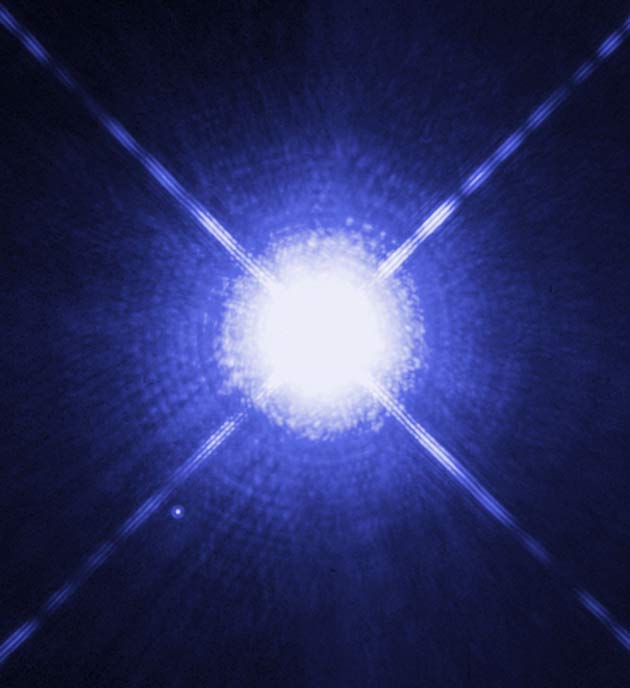Nearby Star Smaller than Earth, Massive as Sun

The brightest star in our sky has a companion that's smallerthan Earth yet 98 percent as massive as the Sun, a new study reveals.
Astronomers already knew the brilliant blue-white Sirius hada stellar companion. But they didn't know the object's mass. The newmeasurement, announced today, was done by an international team of astronomersusing the Hubble Space Telescope.
Sirius is one of the closest known stars at 8.6 light-yearsaway. It is twice as massive as the Sun and has a surface temperature of 18,000degrees Fahrenheit (10,000 degrees C).
The companion, called Sirius B, was known to be much hotter.It is the scorching ember of a Sun-like star now called a white dwarf, and it'sthe nearest of its kind. It was discovered in 1862 but close scrutiny isdifficult because of the glare of the primary star.
"Studying Sirius B has challenged astronomers for more than140 years," said Martin Barstow of the University of Leicester, U.K.
The white dwarf's mass was calculated by noting how itsintense gravitational field alters the wavelengths of light emitted by the mainstar. The results are published in the Monthly Notices of the RoyalAstronomical Society.
White dwarfs are involved in explosions called Type Ia supernovas, which are used to measure cosmological distances and the universe'srate of expansion.
Get the Space.com Newsletter
Breaking space news, the latest updates on rocket launches, skywatching events and more!
"Measurements based on Type Ia supernovae are fundamental tounderstanding 'darkenergy,' a dominant repulsive force stretching the universe apart," Barstow said. "Also, the method used to determine the white dwarf's mass relies on one ofthe key predictions of Einstein's theory of General Relativity; that lightloses energy when it attempts to escape the gravity of a compact star."
Sirius B, at just 7,450 miles (12,000 kilometers) indiameter, has an intense gravitational field. A person weighing 150 pounds (68kilograms) on Earth would weigh 55 million pounds (25 million kilograms)performing the highly inadvisable feat of standing on Sirius B.
Based on Einstein's theory, light from the surface of thehot white dwarf has to climb out of this gravitational field and is stretchedto longer, redder wavelengths of light in the process.
The new observations also refined the measurement of SiriusB's surface temperature to be 45,000 degrees Fahrenheit (25,000 degrees C).
Sirius resides in the winter constellation Canis Major.
- White Dwarf Sends Ripples Through Red Spider Nebula
- Detailed Measures Taken of Closest Star System, Alpha Centauri
- Naked White Dwarf Shows its Dead Stellar Engine
Join our Space Forums to keep talking space on the latest missions, night sky and more! And if you have a news tip, correction or comment, let us know at: community@space.com.

Rob has been producing internet content since the mid-1990s. He was a writer, editor and Director of Site Operations at Space.com starting in 1999. He served as Managing Editor of LiveScience since its launch in 2004. He then oversaw news operations for the Space.com's then-parent company TechMediaNetwork's growing suite of technology, science and business news sites. Prior to joining the company, Rob was an editor at The Star-Ledger in New Jersey. He has a journalism degree from Humboldt State University in California, is an author and also writes for Medium.









